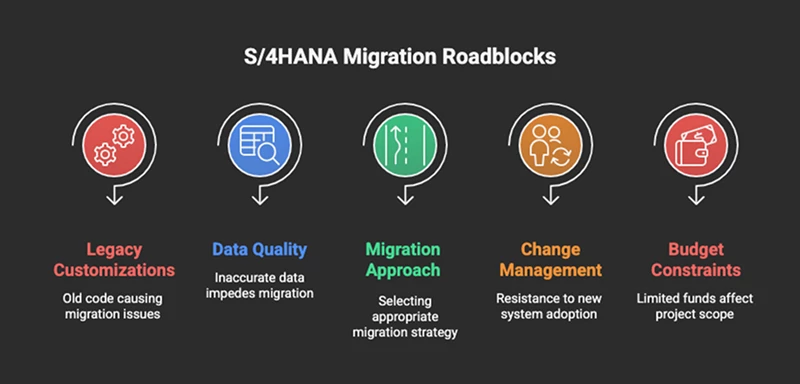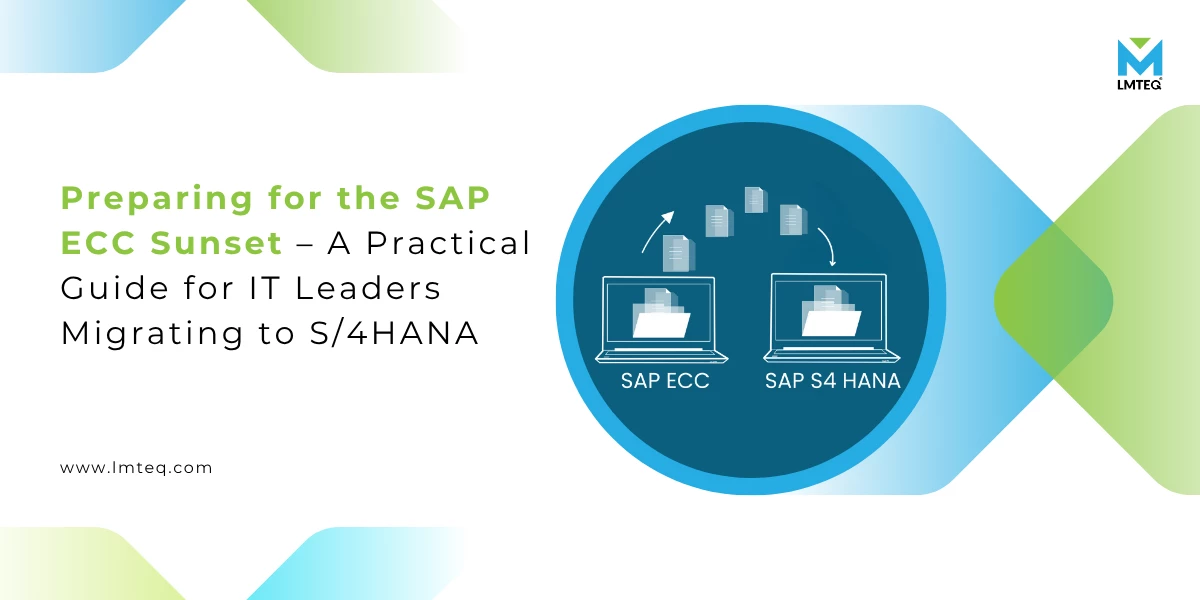The clock is ticking on SAP ECC. With mainstream support ending in 2027 and extended support available only at a premium until 2030, organizations running ECC are on a countdown. This is not just another upgrade cycle — it’s a complete transformation.
For IT leaders, the transition from SAP ECC to S/4HANA represents both a technical challenge and a strategic opportunity. In this blog, we’ll explore what the ECC sunset means, how you can plan your SAP S/4HANA roadmap, and why acting early is critical. Whether you’re in manufacturing, healthcare, BFSI, or any asset-intensive sector, this guide is built to help you make informed decisions and avoid common pitfalls.
What the ECC Sunset Means for Enterprises
The SAP ECC sunset is not a distant possibility — it’s a confirmed deadline with real consequences for organizations that delay. SAP has officially announced the end of mainstream maintenance for ECC in 2027, followed by extended support until 2030—but that comes at a steep premium. While some organizations hope for a grace period or another extension, SAP has made it clear: SAP S/4HANA is the future, and ECC’s days are numbered.
Key Timelines to Know

- December 31, 2027 – End of mainstream maintenance for SAP ECC.
- 2027–2030 – Limited innovation, slow patch cycles, and reduced ecosystem support.
- January 1, 2028, to December 31, 2030 – Optional extended support (with increased cost).
This timeline sets a hard stop for business continuity planning. IT leaders must either begin migration or accept increasing operational risk.
The Risk Landscape After 2027
Operating on ECC after 2027 creates serious exposure across compliance, security, and business continuity:
1. Security and compliance concerns
Post-2027, ECC will no longer receive regular security updates unless you opt into extended support. This raises audit red flags and increases vulnerability to cyber threats, especially in regulated industries like healthcare and BFSI, where non-compliance penalties can be significant.
2. Innovation gap
SAP’s product innovation is fully focused on S/4HANA. Emerging features — such as embedded analytics, machine learning, and cloud-native APIs — are exclusively available in the S/4HANA environment. Staying on ECC effectively means freezing your enterprise core in time, while competitors advance.
3. Vendor and partner limitations
Many SAP ecosystem partners, including ISVs and managed service providers, are shifting support away from ECC. This reduces your options for third-party integrations, functional enhancements, and external consulting.
The Hidden Cost of Sticking with ECC
Some enterprises consider extended support as a way to “buy time.” But this strategy has a hidden price tag:
- Extended support costs are significantly higher — SAP charges a premium, and you’re still left with a legacy system.
- Ongoing technical debt — Maintaining outdated ABAP customizations, legacy interfaces, and siloed data models increases complexity and operating cost.
- Productivity loss — ECC’s limitations in usability, automation, and integration begin to slow down processes just when agility is most needed.
In short, every year you delay the migration adds to your technical debt, operational risk, and lost opportunity. It’s not just about the 2027 deadline — it’s about what your enterprise can’t do until you make the move to S/4HANA.
Migrating to SAP S/4HANA is not just about upgrading from a legacy system — it’s about unlocking the next stage of digital transformation. While the ECC sunset sets the urgency, the true incentive lies in the strategic advantages S/4HANA delivers.
Whether you’re in manufacturing, BFSI, or healthcare, moving to S/4HANA offers a tangible opportunity to modernize operations, drive efficiency, and integrate seamlessly across your IT landscape.
Real-Time Intelligence with HANA In-Memory Computing
At the heart of SAP S/4HANA is the HANA in-memory database — a powerful engine that processes and analyzes massive datasets in real time. This marks a dramatic shift from the traditional batch-processing models of ECC.
With in-memory computing, organizations can:
- Run complex queries and reports in seconds rather than hours.
- Eliminate data latency across departments.
- Enable predictive analytics for finance, supply chain, and operations.
This real-time access to enterprise data is a game changer for industries like manufacturing (for production monitoring), BFSI (for real-time financial consolidation), and healthcare (for faster clinical decision-making).
Streamlined Business Processes and Intuitive UI with SAP Fiori
SAP S/4HANA is built with simplification at its core — both in data model and user interaction.
Key improvements include:
- SAP Fiori UX: A modern, responsive interface that adapts across desktop, tablet, and mobile. Business users get tailored dashboards, fewer clicks, and better productivity.
- Simplified data structures: Redundant tables and indexes found in ECC are eliminated. This speeds up reporting and reduces data storage needs.
- End-to-end process automation: Built-in workflows, intelligent robotic process automation (RPA), and rule-based engines reduce manual intervention.
For CIOs and IT leaders, this translates into faster user adoption, lower support costs, and more reliable data flows across departments.
Built for Cloud, Ready for Any Deployment Model
Unlike ECC, which was fundamentally on-premise, SAP S/4HANA is cloud-native, offering unmatched flexibility in how you deploy:
You can choose:
- On-premise: Full control over infrastructure and data for industries with strict data governance needs.
- Public or private cloud: Lower TCO, faster scalability, and reduced hardware management.
- Hybrid: Run critical workloads on-prem while offloading others to the cloud.
- RISE with SAP: A bundled, subscription-based offering that includes infrastructure, tools, and transformation service
The cloud-ready architecture allows IT leaders to right-size their environments and move at their own pace, without vendor lock-in or operational disruption.
Integration Potential with Platforms like ServiceNow
One of the most powerful, often overlooked advantages of SAP S/4HANA is its open integration framework. With modern APIs and event-driven architecture, S/4HANA easily integrates with third-party platforms, and ServiceNow is a perfect complement.
Here’s how the integration plays out:
- Incident and change management: Sync SAP system issues to ServiceNow ITSM for faster triage and resolution.
- Procurement workflows: Automate purchase requisition approvals across SAP and ServiceNow, reducing delays.
- HR onboarding and asset provisioning: Coordinate employee data, device assignments, and app access across both systems.
With ServiceNow + SAP S/4HANA, IT teams can orchestrate a seamless flow of data and actions — from ticket creation to final resolution — all while providing end users with a unified experience.
Common Roadblocks in SAP ECC to S/4HANA Migration

While the benefits of SAP S/4HANA are clear, the path to migration is anything but straightforward. IT leaders across industries often encounter a set of recurring challenges — technical, organizational, and strategic — that can slow or derail the transformation journey.
Understanding these roadblocks early is critical to crafting a successful roadmap that avoids rework, budget overruns, or business disruptions.
Legacy Customizations and Technical Debt
Many ECC implementations have evolved over the years into highly customized environments, especially in manufacturing and BFSI sectors. These custom ABAP programs, Z-tables, and hard-coded business rules often lack documentation, making it difficult to assess their relevance or compatibility with S/4HANA.
Key concerns:
- Will custom code break during migration?
- Should we rewrite or retire old modules?
- How do we preserve critical business logic?
SAP’s Custom Code Analyzer helps inventory, score, and triage your customizations — so you migrate what matters and sunset what doesn’t.
Data Quality and Master Data Complexity
Garbage in, garbage out. Poor data quality is one of the most cited reasons for ERP failures. ECC systems often contain outdated, duplicate, or orphaned data, especially in materials management, customer records, and vendor lists.
Migrating to S/4HANA with messy data means:
- Slower performance due to bloated tables.
- Failed validations during testing.
- Poor decision-making based on inaccurate reports.
Before migration, organizations must cleanse and harmonize data, often using SAP Data Services or third-party ETL tools. LMTEQ provides pre-migration data profiling to ensure only clean, lean data flows into the new system.
Choosing the Right Migration Approach – Greenfield, Brownfield, or Hybrid
1. Greenfield (re-implementation)
- Reengineer processes
- Eliminate legacy baggage
- Adopt best practices from the ground up
2. Brownfield (system conversion)
Convert your existing ECC system to S/4HANA while preserving configuration and data. Best for companies:
- With stable processes
- Wanting faster time to value
- Avoiding change management disruption
3. Hybrid (Selective Data Transition)
A phased, modular migration that lets you combine new and existing processes. This approach works well for large, complex enterprises looking to:
- Migrate in waves
- Reduce risk
- Align with business units gradually
Each path has trade-offs. LMTEQ’s advisory team runs discovery workshops to help stakeholders align on a strategy that fits timelines, budgets, and risk tolerance.
4. Change Management and User Adoption
Technology alone doesn’t drive transformation — people do. A common pitfall in S/4HANA projects is underestimating the scope of change management.
Even with SAP Fiori’s improved UX, business users face:
- New navigation paradigms
- Updated approval workflows
- Role-based access changes
Without structured onboarding, training, and communication, adoption lags, and resistance builds.
At LMTEQ, we design role-based enablement programs that blend functional training with hands-on simulation labs, ensuring smoother ramp-up and fewer helpdesk tickets post-go-live.
5. Budgeting and Timeline Constraints
S/4HANA migration is not a weekend project. It demands capital, cross-functional coordination, and dedicated bandwidth from IT and business units.
The typical missteps:
- Underestimating integration and testing efforts
- Committing to overly aggressive timelines
- Treating migration as an IT-only initiative
With our phased blueprinting, we help clients scope realistic budgets, identify quick wins, and secure C-suite buy-in to maintain executive alignment throughout the program.
Your SAP S/4HANA Migration Roadmap

Migrating from SAP ECC to S/4HANA is a complex journey that requires meticulous planning and execution. A well-defined roadmap can turn this challenge into a structured, manageable process, reducing risk and accelerating time to value.
Here’s a practical step-by-step guide to help you and your team navigate the migration with confidence:
Step 1 – Discovery and Readiness Assessment
Before committing resources, conduct a comprehensive discovery phase:
- Inventory current ECC landscape: Document customizations, integrations, interfaces, and data volumes.
- Assess business process maturity: Identify outdated or inefficient processes ripe for redesign.
- Evaluate infrastructure: Determine hardware, cloud readiness, and network capacity.
- Conduct SAP Readiness Check: Use SAP’s tools to analyze your ECC system’s compatibility with S/4HANA.
- Stakeholder alignment: Engage IT, finance, operations, and business leaders to align expectations and priorities.
This phase lays the foundation for an informed migration strategy, budgeting, and timeline.
Step 2 – Define Migration Strategy
Based on the discovery, choose the migration approach:
- Greenfield: For reengineering and modernization.
- Brownfield: For system conversion, preserving existing processes.
- Hybrid: For phased or selective transitions.
This choice will affect project scope, complexity, and risk profile.
Step 3 – Data Preparation and Cleansing
Clean, accurate master and transactional data are crucial:
- Eliminate duplicates, obsolete records, and inconsistencies.
- Harmonize data formats and coding standards.
- Validate critical datasets to minimize migration errors.
- Leverage SAP Data Services or third-party tools for extraction, transformation, and loading (ETL).
This step enhances system performance and user trust post-migration.
Step 4 – System Build and Custom Code Adaptation
- Set up your new S/4HANA environment — on-premise, cloud, or hybrid.
- Use SAP’s Custom Code Analyzer to identify incompatible code.
- Re-engineer or retire obsolete customizations.
- Build new extensions aligned with S/4HANA best practices.
- Configure new SAP Fiori apps tailored to user roles.
Step 5 – Integration and Testing
- Connect S/4HANA with your wider IT ecosystem (e.g., ServiceNow for ITSM).
- Run thorough unit, integration, and user acceptance testing (UAT).
- Test critical business scenarios end-to-end to catch issues early.
- Engage key users in testing to facilitate smoother adoption.
Step 6 – Training and Change Management
- Develop role-based training materials and sessions.
- Use simulations, hands-on workshops, and e-learning platforms.
- Communicate migration benefits, timelines, and impacts to all stakeholders.
- Create a support structure for post-go-live issues.
Step 7 – Go-Live and Support
- Plan a phased or big-bang cutover based on risk tolerance.
- Monitor system performance and user issues closely.
- Provide rapid response teams to troubleshoot and resolve post-launch problems.
- Collect feedback for continuous improvement.
Step 8 – Continuous Optimization
- Leverage embedded analytics and SAP BTP for ongoing performance insights.
- Identify automation opportunities and new digital use cases.
- Plan periodic updates and patches in alignment with SAP’s roadmap.
Choosing the Right Partner for Your SAP Migration
Migrating from SAP ECC to S/4HANA is a transformational initiative that touches every aspect of your enterprise IT and business operations. To maximize success and minimize risk, choosing the right migration partner is critical.
Here’s what IT leaders should prioritize when selecting a partner:
Deep SAP Expertise and Proven Track Record
Look for partners with extensive experience across SAP landscapes — especially those who have successfully executed complex ECC to S/4HANA migrations in industries like manufacturing, healthcare, and BFSI.
A partner who understands SAP’s evolving ecosystem, licensing models, and compliance requirements can help you navigate technical challenges efficiently.
End-to-End Services and Advisory
The best partners provide comprehensive services — from readiness assessments, custom code analysis, data cleansing, and system configuration, to integration, change management, and post-go-live support.
Avoid vendors that only deliver technical migration but lack strategic advisory or business process expertise.
Integration and Automation Capabilities
With digital ecosystems growing, your SAP system needs to integrate seamlessly with platforms like ServiceNow for IT service management, workflow automation, and beyond.
Partners who bring strong integration skills ensure your ERP ecosystem is connected, agile, and future-ready.
Customer-Centric Approach and Collaboration
Migration success hinges on clear communication, collaborative planning, and tailored solutions aligned to your business goals, not a one-size-fits-all template.
Select a partner who invests in stakeholder alignment workshops, ongoing training, and post-migration optimization.
Why LMTEQ?
As an official SAP Silver Partner, LMTEQ combines deep SAP domain knowledge with proven migration frameworks tailored to your industry’s unique needs.
Our end-to-end approach:
- Expert assessment and custom code rationalization.
- Data cleansing and master data management.
- Seamless integration with ServiceNow and other platforms.
- Comprehensive change management and training.
- Continuous optimization post-migration.
We prioritize minimal disruption, accelerated timelines, and maximum ROI — helping enterprises migrate from ECC to S/4HANA faster and with confidence.
Also Reads:
Final Thoughts
The SAP ECC sunset is inevitable, and the clock is ticking. For enterprises aiming to stay competitive, compliant, and innovative, migrating to SAP S/4HANA is no longer optional — it’s essential.
S/4HANA offers transformative advantages: real-time insights through HANA in-memory computing, streamlined business processes with SAP Fiori, flexible cloud deployment options, and robust integration capabilities with platforms like ServiceNow.
While migration poses challenges—from custom code adaptation to data quality and change management—a well-planned roadmap and the right partner can turn complexity into opportunity.
Take the Next Step with LMTEQ
As an official SAP Silver Partner, LMTEQ specializes in seamless, accelerated migrations from ECC to S/4HANA tailored to your industry and business needs.
Our proven frameworks, expert advice, and deep integration capabilities help you:
- Minimize risk and downtime
- Maximize operational efficiency
- Unlock new digital growth opportunities
Don’t wait until 2027. Contact LMTEQ today to schedule your SAP ECC to S/4HANA migration readiness assessment and take control of your digital transformation journey.

